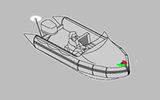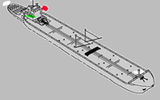
| Added | Fri, 17/03/2017 |
| Источники | |
| Версии |
On water as on land, to prevent accidents it is very important to see other vehicles, as well as to be noticed by them. This court in ancient times was equipped with signal lightsthat are clearly visible to the human eye. Optical signals used in poor visibility (usually from sunset to sunrise, and when fog - around the clock) include identification and signal lights. They allow the observer to determine the position and direction of movement of another vessel in relation to its.
Navigation lights — a set of lighting devices intended to indicate the vessel or aircraft, specify the type and nature of traffic or Parking at night.
Navigation lights of ships and vessels of "river-sea" should meet the requirements of the International regulations for preventing collisions (COLREGs).
Navigation lights of river boats on the inland waterways of the Russian Federation must meet the requirements of Rules of swimming on internal waterways of the Russian Federation.
The signal lights include a white masthead light at the bow on the front mast and the second mast-head light at the stern. Both Shine forward 225°, i.e. from the median plane of the ship in each direction on 112,5°. They should be visible at a minimum distance of 5 nautical miles (9.26 area km).
Currently, as navigation lights use electric lamps, equipped with Fresnel lenses and light filters. Before the invention of electricity of the court was also supplied with lights with various glass inserts.
The stern lantern in the XVI-XVIII centuries. [7]
Types of navigation lights in accordance with COLREGs (International regulations for Preventing Collisions)
Masthead light is a white light located in the median plane of the ship, illuminating continuous light arc of the horizon of 225° and placed so as to Shine from the direction directly in the nose to 22.5° behind the beam of each side.
The side lights represent a green light on the starboard side and red light on the left side. Each of these lights will illuminate continuous light arc of the horizon of 112,5° and set so as to Shine from the direction directly in the nose to 22.5° behind the beam of the corresponding side. For vessel length less than 20 meters the sidelights may be combined in one lantern put in the diametrical plane of the vessel.
The stern light is a white light, to the extent practicable, closer to the stern. Lights continuous light arc of the horizon of 135° and is set to Shine from the direction directly on the stern to 67.5° towards each side.
Tow fire is a yellow light having the same characteristics as the "stern light" described in paragraph 3 of this Rule.
A circular fire is the fire that illuminates with a continuous light arc of the horizon of 360°.
Flash fire is a fire, giving glimpses at regular intervals with a frequency of 2 or more flashes per second.
In PWP of the Russian Federation (Rules for navigation on inland waterways of the Russian Federation) there are more advanced flash light color or white — flashing lamp that emits light in an arc of the horizon of 112,5° from the beam of the vessel to the bow or stern overlapping the diametrical plane of the vessel to 22.5°. Flash light is night and day alarms. In the absence of flash lights, search lights permitted the use of night lighting visual signal (blinking white light), and the flag-visual signal;
Navigation lights are visible at the following minimum distances:
On vessels with a length of 50 m or more
- masthead light - 6 nautical miles;
- on-Board fire - 3 miles;
- stern light - 3 mile;
- towing the fire - 3 miles;
- white, red, green or yellow light visible from all directions - 3 miles.
On vessels with a length of 12 m and over but less than 50 m
- masthead light - 5 miles, but if the length of vessel less than 20 m, 3 miles;
- on-Board fire - 2 miles;
- stern light - 2 miles;
- tow fire - 2 miles;
- white, red, green or yellow light visible from all directions - 2 miles.
On vessels of length less than 15 m
- masthead light - 2 mile;
- on-Board fire - 1 mile;
- stern light - 2 miles;
- tow fire - 2 miles;
- white, red, green or yellow light visible from all directions - 2 miles.
Subtle half-sunk vessels towed or towed objects
- white circular fire - 2 miles.
Signal lights and shapes
a — tow and towed the caravan with a length of over 183 m on the move;
b — "cannot be controlled" the ship on the move;
with cable and boeukladki, surveying the ship on the move;
d — cable - and boeukladki, surveying the ship without a course;
e — "can't cope", a ship without a course;
f is a ship with dangerous cargo on Board;
g — a vessel with a length of less than 45,75 m on the rocks;
h — the ship of length less than m 45,75 at anchor;
i — vessel conducting fishing (trawler) on the move;
j — a vessel with a length of more than 45,75 m on the rocks;
it is a ship with a length of more than 45,75 m at anchor;
l — vessel conducting fishing (not trawling), on the move;
m — vessel conducting fishing (no trawl), the length of fishing gear which is horizontally exceed 153 m, without progress;
n is a pilot vessel when on duty on the go.
Thus, almost from the beginning of the trip on the water was developed by the special signals that allow in conditions of poor visibility to show your location and evaluate the location of nearby vessels.
From the point of view of a researcher of the paranormal can be very helpful to know the above information. For example, a ship without signal lights may be perceived as a Ghost ship. On the other hand, the signal lights of the vehicle in the dark can be mistaken by a casual observer, for example, an NGO or a UFO.
For assistance in the preparation of material take thanks K_V_A
Translated by «Yandex.Translator»
Log in or register to post comments


















